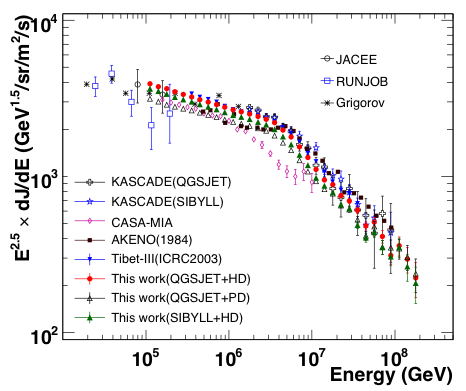Cosmic-Ray Energy Distribution and Species of Cosmic-Ray Nuclei
The "ultra high energy" refers to the energy range from 1012 eV - 1016 eV. The energy distribution of ultra-high-energy cosmic rays, summed over all the nuclear species, has a break point around 4 x1015 eV. This point is called the "Knee", and suggests the maximum energy up to which cosmic rays are accelerated within their source. Meanwhile, the standard theoretical model to produce ultra-high-energy cosmic rays considers the acceleration of cosmic rays by a shockwave accompanying a supernova remnant in the Galaxy. Based on this model, the maximum acceleration energy of a cosmic-ray nucleus is linearly proportional to its atomic number (Z). We can therefore verify the shockwave acceleration model of the supernova remnant, if we measure the energy distribution of each cosmic-ray nuclear species separately, and observe their linearly Z-dependent Knee energies.
Cosmic-ray energy distribution measured by various experiments. The X and Y axes represent the energy and the rate of cosmic rays, respectively (106 GeV = 1015 eV). The rate rapidly decreases above ~4 x 1015 eV.
(Amenomori et al., ApJ, 678, p1165, 2008)

Supernova remnant "SN 1006" in Lupus, located at a distance of ~7,200 light years from the Earth. The progenitor supernova of this nebula appeared in the year 1006.
Image Credit: NASA, ESA, Zolt Levay (STScI)

